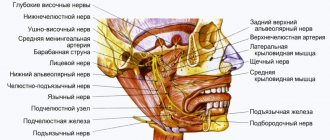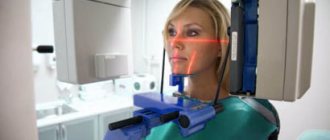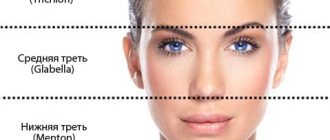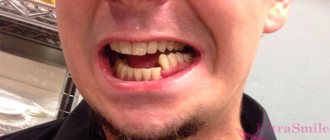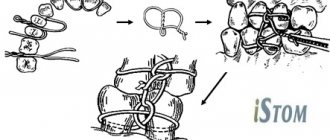- Surgical department
Surgical department » - Maxillofacial Surgery
Maxillofacial Surgery "
- Jaw osteotomy
Malocclusion is a violation of the process of chewing food and swallowing it, a negative effect on the speech apparatus, as well as an aesthetic defect. With malocclusions, the upper and lower jaws can be enlarged or reduced in size, pushed forward or positioned posterior to the normal position, shifted to the side or tilted, turning clockwise or counterclockwise. In this case, the closure of the teeth is disrupted to one degree or another, they change the angle of inclination, turn around, run into each other (crowding) or diverge with the formation of cracks (treme).
What are the dangers of malocclusion?
- Violation of dental contacts makes it difficult to chew food and provokes the development of diseases of the gastrointestinal tract.
- Severe malocclusions so limit the possibilities of normal nutrition that they are a reason for deferment from the army.
- Changing the angles of inclination of the teeth affects the distribution of the load during chewing, leads to overload of the periodontium, the development of gum inflammation and, ultimately, earlier tooth loss.
- Teeth crowding, combined with misalignment, affects the natural cleaning of teeth, further leading to the development of gum disease and an increased likelihood of tooth enamel destruction. If tooth loss has already occurred, then violations of the jaw relationships can create difficulties in prosthetics.
- Malocclusion leads to a change in the trajectory of jaw movement during chewing: the temporomandibular joints are overloaded, and dysfunction of the temporomandibular joints develops.
- Some types of malocclusion are anatomical prerequisites for narrowing the airways, for the appearance of snoring and such a serious condition as sleep apnea.
The invention relates to the field of medicine, to maxillofacial surgery, and can be used in the treatment of patients with gnathic forms of dentoalveolar anomalies, who are indicated for combined treatment using orthognathic surgery techniques, namely, osteotomy of the lower jaw. Can be used by maxillofacial surgeons in dental, surgical and other hospitals as part of an algorithm for complex treatment of patients with gnathic forms of dentofacial anomalies.
Anomalies in the development of the dental system are a symptom of a developmental disorder of the entire organism, for example, hormonal discorrelation or a genetically determined anomaly in the development of the human skeleton. The occurrence of pathology in the size and shape of the jaws is observed with hereditary predisposition and congenital anomalies of the maxillofacial region (congenital clefts of the lip, alveolar process and palate, hemifacial microsomia, Robin and Goldenhar syndrome), developmental disorders of the temporomandibular joints, jaw injuries with damage to growth zones, as well as after rickets and diseases associated with metabolic disorders and, in particular, calcium metabolism and endocrinopathies [1].
According to the US National Institute of Dentistry, 35% of the population has anomalies and deformations of the facial skull, which in 5-15% require surgical treatment [2].
According to a number of authors, dentofacial anomalies are one of the most common problems in the maxillofacial region, and the treatment of patients with deformities of the dentofacial system remains a pressing problem throughout the world [2, 3, 4, 5]. The concept of the term “anomalies of the dentofacial system” includes a significant deviation in the proportions of the maxillary-mandibular complex from the normal (generally accepted) ones, which negatively affects the relationship of the teeth in each dentition and between the dentitions as a whole. Complaints from patients with anomalies of the dentofacial system can be divided into two main groups: functional (occlusion disorders, pathology of the temporomandibular joints, speech disorders, chewing, etc.) and aesthetic (facial disproportions, asymmetry).
There is a known method of surgical treatment of gnathic forms of dentoalveolar anomalies, which consists of a combined treatment consisting of orthodontic and surgical (orthognathic surgery) stages. Moreover, depending on the nature of the anomaly and the presence of additional symptom complexes, additional interventions may also be performed.
Modern orthognathic surgery is a highly predictable and effective functional and aesthetic intervention (Drobyshev A.Yu. et al., 2007; Chambers PA at al., 1999; Mommaerts MY at al., 2000). And the improvement of surgical protocols used during orthognathic operations is a pressing issue, to which many research works are devoted (Chambers R.A. at al., 1999; Mommaerts MY at al., 2000; Anderson JG at al., 2002; Guzel MZ at al., 2007).
The essence of orthognathic surgery comes down to performing various types of osteotomies of the upper and/or lower jaws in order to move them relative to each other to create the most correct occlusal relationships.
The history of mandibular osteotomy began with Hullihen in 1846, who performed a mandibular osteotomy to correct prognathia. Later, in the early 1900s, Blair performed a horizontal osteotomy of the mandibular ramus. In the 1920s and 1930s, a number of modifications to the mandibular osteotomy were performed by Limberg, Wassmund, and Kazanjian. But all these modifications could not provide rigid stability and resulted in relapses. In 1942, Schuchardt first described what would later become the modern protocol for mandibular intercortical osteotomy (BSSO) with an intraoral approach. In 1954, Caldwell and Letterman described a vertical ramus osteotomy technique that was aimed at preserving the integrity of the mandibular nerve. And already in 1957, Obwegeser HL described the most practical technique of intercortical osteotomy of the mandible, which would be adopted as the standard protocol (BSSO) for the correction of dentofacial anomalies.
Despite the numerous variations of osteotomy of the mandible, the most common of which is still intercortical osteotomy (Bilateral Sagittal Split Osteotomy), their main essence is the formation of completely freed fragments of the mandibular branch with the condylar process for the subsequent movement of the body fragment with the dentition and rigid fixation.
After intercortical osteotomy of the lower jaw and complete mobilization of the fragments of the lower jaw with condylar processes, a large fragment of the lower jaw (body with dentition) is positioned in an orthognathic relationship with respect to the upper dentition. This is followed by rigid fixation of small fragments.
A peculiarity of the development of the lower jaw in patients with gnathic forms of dentofacial anomalies is its shape. In some cases, this group of patients showed an increase in the angle between the body and the ramus of the lower jaw, which makes its contour smoothed and not aesthetically attractive. This is what served as the impetus for the development of a modified intercortical osteotomy of the mandible, which consists in modifying its osteotomy in order to improve the aesthetic parameters of the contour of the mandible after orthognathic surgery.
The objective of the present invention was to improve the aesthetic result of the operation through the use of the created method of intercortical osteotomy of the lower jaw during orthognathic surgery in patients with gnathic forms of dentoalveolar anomalies.
This problem is solved by the fact that in the known prototype method of intercortical osteotomy of the mandible, the anatomical features of the structure of the mandible in the area of the corners are not taken into account, namely, the angular relationship between the body and the branch of the mandible, which in some cases is manifested by a flattened shape of the jaw in the area of the corners with insufficient expression. As a result, after moving the lower jaw using the classical method, the anatomical shape in the area of the corners does not change, which has a negative effect on aesthetics. The addition of additional osteotomy lines allows one to recreate a more correct (sharper) angle between the ramus and the body of the lower jaw and thus achieve a more pronounced angle of the lower jaw and the correct aesthetic contour of the lower third of the face.
The technical result of this operation is an increase in the angular relationship between the body and the branches of the lower jaw and, as a result, an improvement in the aesthetic parameters of the contour of the lower jaw in patients with gnathic forms of dentofacial anomalies.
Attached illustrations:
Figure 1. Orthopantomogram of the patient after a modified intercortical osteotomy of the lower jaw (B - large fragment, M - small fragment, teeth 3-7 and 8, 1 - vertical osteotomy line, 2 - horizontal osteotomy line, 3 - fragments of the corners on a large fragment) .
Figure 2.1, 2.2 and 2.3 Multislice computed tomography, three-dimensional reconstruction from different projections. On the left is the state before surgery, on the right - after surgery (signs of a modified intercortical osteotomy of the lower jaw are visible).
Figure 3.1, 3.2 and 3.3 Multislice computed tomography, three-dimensional reconstruction from different projections. On the left is the state before surgery, on the right - after surgery (signs of a modified intercortical osteotomy of the lower jaw are visible).
The modified intercortical osteotomy of the mandible according to the invention is carried out as follows (illustration attached).
A cut is made from the inner surface of the branch of the lower jaw, above or below the entry point of the mandibular nerve, along an oblique line with a transition to the outer side of the body of the lower jaw and continuing until the projection of the eighth, seventh or sixth molar of the lower jaw (Fig. 1-3), after whereby a vertical cut is made not to the entire height of the body of the lower jaw, as with the classical method, but to 1/3-1/2 of its height (Fig. 1-1). Next, having peeled off the soft tissue from the outer surface of the branch of the lower jaw in the area of the angle, a horizontal cut is made parallel to the lower edge (1 cm apart) of the angle and the body of the lower jaw from the posterior surface of the branch in the area of the angle of the lower jaw (Fig. 1-2) to the previously made vertical cut in the projection of the eighth, seventh or sixth molar (Fig. 1-1). All cuts are made through the entire thickness of the outer cortical layer. Next, using chisels, the body and branches of the lower jaw are split along the lines of previously made cuts. Similar manipulations are performed on the opposite side of the lower jaw.
After intercortical osteotomy of the mandible, a large fragment is formed (the body of the mandible with the alveolar process and dentition and partially preserved angles, Fig. 1-3) and two small fragments (part of the outer cortical plate of the body of the mandible, which passes into a branch with the coronoid and condylar processes , Fig. 1-M).
Then a large fragment (the body of the lower jaw with the alveolar process and the dentition), using a previously made splint (positioner), is fixed to the upper jaw in an orthognathic relationship. Small fragments are positioned and fixed to the large one with titanium plates and screws.
Clinical studies and practical use of the proposed method of intercortical osteotomy of the lower jaw during orthognathic surgery in patients with gnathic forms of dentoalveolar anomalies to improve aesthetic indicators were carried out in the conditions of the Department of Adult Maxillofacial and Plastic Surgery of the Moscow State Medical and Dental University named after A.I. Evdokimov" showed its high efficiency. The proposed method of intercortical osteotomy of the mandible during orthognathic surgery in patients with gnathic forms of dentoalveolar anomalies ensured improved aesthetics in the area of the angles of the mandible, which improved the patient’s quality of life.
The implementation of the proposed method of intercortical osteotomy of the lower jaw during orthognathic surgery in patients with gnathic forms of dentofacial anomalies to improve aesthetic indicators is illustrated by the following clinical examples.
Clinical Case 1 (Fig. 2.1, 2.2 and 2.3)
Patient F., 27 years old, was admitted to the clinic with a diagnosis of skeletal class III. Excessive development of the lower jaw and chin. Underdevelopment of the upper jaw. Congenital deformation of the osteochondral parts of the nose."
Complaints of discomfort while chewing food, eating disorders, aesthetic disharmony of the face, deformation of the nose.
The patient is fully prepared for surgery according to the standards of medical care.
The patient underwent surgery: osteotomy of the upper jaw according to Le Fort type I, modified intercortical osteotomy of the lower jaw, rhinoplasty.
Regarding surgical treatment, the patient underwent the entire complex of preoperative planning of a double-jaw orthognathic operation with the production of two splints (positioners), which were used intraoperatively to move and correctly position the upper and lower jaws relative to each other (formation of correct interocclusal relationships) and relative to the parameters of the facial skeleton.
After the patient was introduced into the ETN under conditions of controlled hypotension and complete preparation for the operation, according to the drawn up plan for the sequence of stages of orthognathic surgery, the first stage was the movement of the upper jaw, followed by rigid fixation.
Next, after administering the local anesthetic Sol. Naropini 0.75% - 10 ml with a scalpel No. 15, an incision was made in the mucous membrane through the entire thickness to the bone along the pterygomaxillary fold with an extension to the transitional fold to the projection of tooth 3.5. Using a sharp rasp, subperiosteal dissection of soft tissues was carried out from the projection of tooth 3.5 along the entire outer surface of the body of the lower jaw towards the angle, moving to the projection of the oblique line and then moving to the inner surface of the branch. The entry point of the mandibular nerve from the inner surface of the branch is visualized. Using a reciprocal saw, a cut was made starting from the inner surface of the ramus of the lower jaw, above the entry point of the mandibular nerve, along an oblique line with a transition to the outer side of the body of the lower jaw and continuing to the projection of the sixth-seventh molar of the lower jaw. Next, a vertical cut was made to 1/2 the height of the body of the lower jaw. The masticatory muscle was detached from the outer surface of the ramus of the lower jaw in the area of the angle, a horizontal cut was made parallel to the lower edge of the body and the angle of the lower jaw from the posterior surface of the ramus in the area of the angle of the lower jaw to the previously carried out vertical cut in the projection of the sixth and seventh teeth. All cuts were made through the entire thickness of the cortical layer without cutting into the spongy layer. Next, using sharp chisels, an osteotomy of the body and ramus of the lower jaw was performed along the line of the previously made cut. The mandibular nerve was visualized, its integrity was not compromised. Similar manipulations were performed on the opposite side of the lower jaw. As a result of the intercortical osteotomy of the mandible, three fragments were formed: a large fragment (the body of the mandible with the alveolar process and dentition, partially preserved angles) and two small fragments (part of the outer cortical plate of the body of the mandible, which passes into a branch with the coronoid and condylar processes) . Then a large fragment of the lower jaw, using a previously made splint (positioner), was fixed to the upper jaw in an orthognathic relationship. Small fragments are positioned and fixed with titanium plates and screws. All wounds are sutured. The patient was transferred to the intensive care unit for 24-hour observation. From the second day, the patient underwent intermaxillary fixation.
The patient was in the hospital for 7 days, where she received antibacterial and anti-inflammatory therapy, and physical therapy. On the eighth day the patient was discharged. The condition at discharge was satisfactory. Postoperative swelling is practically absent. The bite is fixed in an orthognathic relationship.
As a result of a modified intercortical osteotomy of the mandible, an improvement in the contour of the mandible and aesthetic proportions of the face was achieved.
Clinical Case 2 (Figures 3.1, 3.2 and 3.3)
Patient D., 30 years old, was admitted to the clinic with a diagnosis of “Asymmetrical deformation of the jaws. III skeletal class. Excessive development of the lower jaw and chin. Underdevelopment of the upper jaw."
Complaints of discomfort while chewing food, eating disorders, aesthetic disharmony of the face.
The patient is fully prepared for surgery according to the standards of medical care.
The patient underwent surgery: osteotomy of the upper jaw according to Le Fort type I, modified intercortical osteotomy of the lower jaw, osteotomy of the mental region.
Regarding surgical treatment, the patient underwent the entire complex of preoperative planning of a double-jaw orthognathic operation with the production of two splints (positioners), which were used intraoperatively to move and correctly position the upper and lower jaws relative to each other (formation of correct interocclusal relationships) and relative to the parameters of the facial skeleton.
After the patient was introduced into the ETN under conditions of controlled hypotension and complete preparation for the operation, according to the drawn up plan for the sequence of stages of orthognathic surgery, the first stage was the movement of the upper jaw, followed by rigid fixation.
Next, after administering the local anesthetic Sol. Naropini 0.75% - 10 ml with a scalpel No. 15, an incision was made in the mucous membrane through the entire thickness to the bone along the pterygomaxillary fold with an extension to the transitional fold to the projection of tooth 3.5. Using a sharp rasp, subperiosteal dissection of soft tissues was carried out from the projection of tooth 3.5 along the entire outer surface of the body of the lower jaw towards the angle, moving to the projection of the oblique line and then moving to the inner surface of the branch. The entry point of the mandibular nerve from the inner surface of the branch is visualized. Using a reciprocal saw, a cut was made starting from the inner surface of the ramus of the lower jaw, above the entry point of the mandibular nerve, along an oblique line with a transition to the outer side of the body of the lower jaw and continuing to the projection of the sixth-seventh molar of the lower jaw. Next, a vertical cut was made to 1/2 the height of the body of the lower jaw. The masticatory muscle was detached from the outer surface of the ramus of the lower jaw in the area of the angle, a horizontal cut was made parallel to the lower edge of the body and the angle of the lower jaw from the posterior surface of the ramus in the area of the angle of the lower jaw to the previously carried out vertical cut in the projection of the sixth and seventh teeth. All cuts were made through the entire thickness of the cortical layer without cutting into the spongy layer. Next, using sharp chisels, an osteotomy of the body and ramus of the lower jaw was performed along the line of the previously made cut. The mandibular nerve was visualized, its integrity was not compromised. Similar manipulations were performed on the opposite side of the lower jaw. As a result of the intercortical osteotomy of the mandible, three fragments were formed: a large fragment (the body of the mandible with the alveolar process and dentition, partially preserved angles) and two small fragments (part of the outer cortical plate of the body of the mandible, which passes into a branch with the coronoid and condylar processes) . Then a large fragment of the lower jaw, using a previously made splint (positioner), was fixed to the upper jaw in an orthognathic relationship. Small fragments are positioned and fixed with titanium plates and screws. All wounds are sutured. The patient was transferred to the intensive care unit for 24-hour observation. From the second day, the patient underwent intermaxillary fixation.
The patient was in the hospital for 9 days, where he received antibacterial and anti-inflammatory therapy, and physical therapy. On the tenth day the patient was discharged. The condition at discharge was satisfactory. Postoperative swelling is practically absent. The bite is fixed in an orthognathic relationship.
As a result of a modified intercortical osteotomy of the mandible, an improvement in the contour of the mandible and aesthetic proportions of the face was achieved.
Bibliography.
1. Bell WH, Jacobs JD, Quejada JG Simultaneous repositioning of the maxilla, mandible and chin. Treatment planning and analysis of soft tissues // A m. J. Orthod. Den tofacial. Orthop. - 1986. - Vol. 89, n 1. - P. 28-50.
2. Baik HS, Sung SJ Effects of maxillary protraction on growth in Class III malocclusion. Korean J Orthod. 1994; 24: 349-366.
3. Drobyshev A.Yu., Anastassov G. Fundamentals of orthognathic surgery. — Moscow: Printed City. - 2007. - 55 p.
4. Proffit WR, Fields HW The etiology of orthodontic problems. In: Proffit WR, Fields HW, eds. Contemporary Orthodontics. St Louis, Mo: CV Mosby; 1986: 112-113.
5. Bezrukov B.M., Sukachev V.A., Ippolitov V.P. Modern problems of reconstructive operations for congenital and acquired deformities of the facial skeleton // Modern principles of reconstructive surgery of the face and neck in the rehabilitation of patients with congenital and acquired pathologies. - M., 1984, - pp. 161-165.
6. Guzel MZ, Sarac M, Arslan H., Nejat E., Nazan K. A New Face by Combined Surgery for Patients with Complex Dentofacial Deformity // J. Aesthetic. Plastic. Surgery. 2007. - Vol. 31, n 1. - P. 32-41.
7. Chambers PA, Yavuzer CR, Jackson I.T., Topf JS, Lash SM One-stage correction of complex facial disproportion // J. Craniofac. Surg. - 1999. - Vol. 10, n 3. - P. 214-221.
8. Mommaerts MY, Lippens F., Abeloos JV, Neyt LF Nasal profile changes after maxillary impaction and advancement surgery // J. Oral. Maxillofac. Surg. — 2000. — Vol. 58, n 5.- P. 470-475.
9. Anderson JG, Laney TJ Combined orthognathic and facial aesthetic surgery with case reports // J. Term.
Dent. Assoc. - 2002. - Vol. 82, n 3. - P. 52-57. A method for performing intercortical osteotomy of the mandible, including detachment of the masticatory muscle from the outer surface of the ramus of the mandible in the area of the angle, making a cut from the inner surface of the ramus of the mandible, above the entry point of the mandibular nerve, along an oblique line with a transition to the outer side of the body of the mandible, continuing to projections of the eighth, seventh or sixth molar of the lower jaw, characterized in that a vertical cut is made on the body of the lower jaw at 1/3-1/2 of the height of the body of the lower jaw, then a horizontal cut is made parallel to the lower edge of the body of the lower jaw with an indentation of 1 cm from the lower edge, in the direction from the posterior edge of the branch in the area of the angle of the lower jaw to the previously made vertical cut in the projection of the eighth, seventh or sixth molar, while all the cuts are carried out through the entire thickness of the cortical layer without cutting into the spongy layer.
Jaw osteotomy surgery
Historically, the first operations were performed on the lower jaw. And the surgeon’s task was precisely to restore normal jaw relationships. But today operations on the lower jaw alone account for no more than 10% of operations performed. Because the surgeon’s tasks have changed: now it is not only the correction of the bite, but also the improvement of facial aesthetics.
Double-jaw osteotomy is an operation on the lower and upper jaw simultaneously, which allows you to achieve aesthetically favorable proportions of the face both in front and in profile, eliminate asymmetry, and make the smile brighter by eliminating dark corridors - shading of the lateral teeth of the upper jaw. We can say that surgery on one jaw is only a correction of functionality, on two – functionality and aesthetics.
Indications for the operation:
- violation of the closure of the dentition, which cannot be corrected orthodontically;
- pronounced facial disproportions that have aesthetic significance.
Contraindications:
- unpreparedness of the dentition for surgery (insufficient orthopedic or orthodontic preparation);
- diseases of internal organs that prevent surgery or anesthesia.
To eliminate lower prognathia, O. Neuer (1962) proposed.
The technique of decortication of the mandibular ramus in the form of a narrow cavity in the horizontal direction above the mandibular foramina, leaving only small bridges of the compact layer along the posterior edge of the ramus. The operation was performed using a submandibular approach. After 2 weeks, a blow to the chin caused a posterior displacement of the lower jaw (like a subperiosteal fracture). In the postoperative period, intermaxillary fixation was performed with a rubber rod. In our opinion, this method does not guarantee against relapse.
To eliminate prognathia of the mandible or its combination with an open bite, R-Ritter (1956) proposed performing an arcuate osteotomy in the area of the lower third of the mandibular ramus, i.e., above the opening of the mandibular canal (Fig. 29).
The lower jaw moves backwards, and in the presence of an open bite, upwards, the teeth are set in an orthognathic bite. Osteosynthesis of bone fragments is carried out using a wire suture. In the postoperative period, intermaxillary fixation is performed using dental splints. O. Neuer (1962), N. Kole (1963) performed the method of partial arcuate resection of the branches of the lower jaw in the same location and for the same indications as R. Ritter.
This technique, in our opinion, is technically complex and requires great precision. It is not without the same disadvantages as horizontal osteotomy of the branches (small contact area of the wound surfaces of bone fragments, the possibility of damage to the neurovascular bundle, etc.).
Among operations on the branches of the lower jaw, oblique “sliding” osteotomy, first performed in our country in 1928 by A. A. Limberg (1924) (Fig. 30), and abroad by G. Regtes (1924), occupies a significant place.
Its essence lies in osteotomy of the jaw ramus from the middle of the semilunar notch to the posterior edge of the ramus, then the large fragment is mixed downwards, sliding the osteotomized edge over the small fragment. The operation ends with osteosynthesis with a wire suture. This surgical method has found wide application in many clinics and specialized hospitals [Kabakov B. D., Vasiliev V. S., 1966; Rudko V.F., 1966 (Fig. 31); Vasiliev V. S., 1967, 1969, 1970 (Fig. 32) and others. ] .
Stages of treatment
Today, the method of combined treatment of malocclusions, when the orthodontist begins work first, is considered generally accepted in the world.
1) Orthodontic stage
The orthodontist places braces on both jaws and begins to move the teeth so that they take the correct position in relation to the jaws. In this case, a temporary deterioration in the closure of teeth occurs. It takes about nine months to prepare. After this, the surgical stage is performed.
2) Surgical stage
The operation is performed under general anesthesia. The intervention is performed via intraoral access, which allows it to avoid leaving scars. In accordance with the treatment plan, cuts are made on the upper and lower jaws, the fragments are mobilized and installed in the most functionally and aesthetically advantageous position. Next, the jaws are fixed with titanium miniplates, which are invisible to the body, do not ring at the airport and do not interfere with MRI. They usually remain in the body for life without causing any consequences. In rare cases, surgery may be performed before orthodontic treatment begins.
In the literature, this method is sometimes called “Swedish”.
In 1910, W. Babcock also used horizontal osteotomy of the branches at the level of their upper third. No bone fixation was performed. WW Babcock inserted a piece of ivory as a spacer between the fragments (Fig. 25).
In the postoperative period, the jaw was fixed using dental splints and rubber traction.
The Czech surgeon F. Kostecka in 1924 performed a horizontal osteotomy of the branches of the lower jaw without a soft tissue incision - blindly. The essence of the operation is as follows. Using a Kerger needle, an injection is made below the earlobe 5-6 mm from the posterior edge of the branch. Then, all the time feeling the medial surface of the jaw branch with the end of the needle, they move it anteriorly towards the lower edge of the zygomatic bone. At the front edge of the branch, the needle pokes out through the cheek. It is important that the needle passes above the entrance to the mandibular canal, between the medial surface of the ramus and the soft tissues containing the neurovascular bundle (inferior alveolar artery, nerve and vein). At the same time as the needle, a silk thread is passed through, held in a hole at the end of the needle. Then they do it in two ways: either the needle is removed, leaving a silk thread in the wound for further insertion of the Gigli saw, or the needle is inserted without the silk thread, and the Gigli saw is fixed to the end of the needle and brought to the level of the posterior edge of the branch. Using sawing movements in a horizontal direction (the skin at this moment must be protected from damage), the jaw branch is cut first on one side and then on the other. After this, the lower jaw is shifted posteriorly until the correct bite is established and fixed to the upper jaw using dental splints and rubber rings for a period of 2 - 3 months, and sometimes more (Fig. 26).
The main disadvantages of the Kostechka method are bleeding, the formation of salivary fistulas, damage to the facial nerve and frequent relapses (up to 50%, according to E. Reichenbach, 1955).
The operation using the Kostechka method in its initial version was used by many surgeons in our country and abroad [Kabakov B. D., Pasternak A. A., 1962; Mukhin M.V., 1963; Egiyan G. M., 1964; Klementov A.V., Vasiliev V.S., 1964; Mikhelson N. M. et al., 1965; Vasiliev V. S., Popov S. E., 1967; PopudrenkoP. I, 1970; Pichler N., 1928; Pearson W. N., 1943; Traunham V. N., 1944; Reichenbach E., 1955; Hinds E. S., 1957; Toman Y., 1957, 1968; Shira R.V., 1961; Urban F., 1961; Ullik R., 1962, etc. ] .
While maintaining the basic principle of the method, a number of surgeons made some modifications to Kostechka’s operation. Thus, A. Zindemann (1921) performed osteotomy of the branches not with a Gigli saw, but with a hacksaw. E. Skaloud (1954) performed this operation using intraoral access. S. M. Davydov (1960) proposed a protective plate to prevent injury to soft tissues and the neurovascular bundle. S. Moose (1945) performed osteotomy of the mandibular branches intraorally using a mechanical saw with a protective plate. To prevent anterior displacement of the small fragment, K. Mushka (1971) proposed fixing the fragments with a wire loop from the semilunar notch to the angle of the jaw; The author passed the wire subcutaneously using a special conductor.
